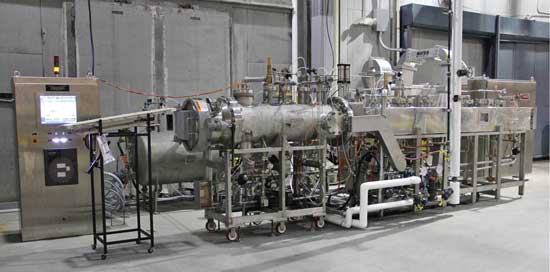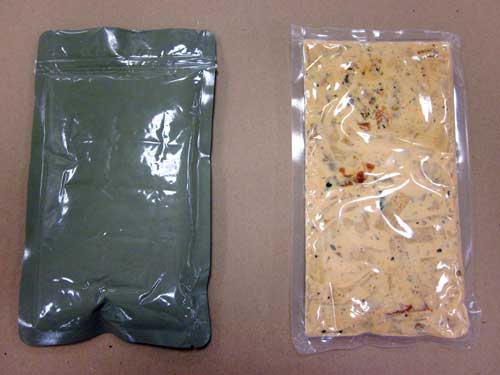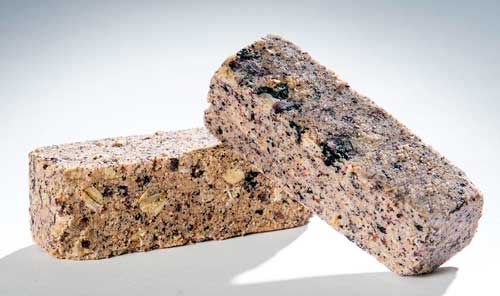Vitamin Stabilization for a Long-Term Spaceflight
Matrix manipulation and innovative processing techniques are critical for stabilizing vitamins in food for a mission to Mars.

Imagine a place so remote and harsh it is anathema to life. Imagine a multiyear journey to that place during which your sustenance has to be carried with you, perhaps complemented by caches left behind by previous travelers. That place is Mars. And the National Aeronautics and Space Administration (NASA) is planning to go there.
Sending astronauts to Mars involves not only the challenge of transporting them there and safely home, but also the equally immense problem of sustaining crews for the duration of the round-trip mission. Each flight leg requires travel time of at least half a year. And voyages would be scheduled only during close alignment of Earth and Mars—which occurs roughly every two years—to minimize travel distance and time. Crews would thus likely be space-bound for a minimum of two and one-half years. While NASA is considering in-space farming as a long-term option, Mars astronauts would at first be eating stockpiled provisions. The goal of separately preshipping this substantial mass and volume of food is the basis of NASA’s five-year shelf-life objective. Ensuring astronauts a safe and nutritious diet for that length of time is the ultimate food shelf-life challenge.
So what would be for dinner? What would be for dinner years into the mission? And how do you ensure that dinner is still nourishing after that time? More specifically, how can you ensure that the nutrients originally in the food have survived?
That question is one being pursued by researchers at the Combat Feeding Directorate (CFD) of the Natick Soldier Research Development and Engineering Center (NSRDEC) under a NASA-funded project concerning stabilization of vitamins for long-term spaceflight. These researchers organized a supporting workshop titled Fundamentals of Vitamin Stabilization, which was held at the National Space Biomedical Research Institute headquarters in Houston in 2014. The workshop focused on the disparate scientific areas that underlie the task of keeping vitamins stable—a task that is crucial for keeping astronauts healthy.
--- PAGE BREAK ---
Vitamin Loss Concerns
Specific vitamins of concern to NASA are vitamins A, B1 (thiamin), B9 (folic acid), C, and E. Vitamin A is crucial for immune function and eye health (Mahan and Escott-Stump 2004). Vitamin B1 is important for regulation of appetite, metabolism, and neural functioning (Mahan and Escott-Stump 2004). Vitamin B9 contributes to red blood cell production, modulation of homocysteine level, and support of neural functioning (Mahan and Escott-Stump 2004). Vitamin C is important for immunity and non-heme iron absorption, and Vitamin E plays a role in mitigation of conditions related to oxidative stress (Mahan and Escott-Stump 2004). Long-term inadequate intake of these nutrients would therefore be expected to severely compromise not only the physical and emotional health of individual astronauts but also the effective integration and functioning of the crew throughout multiyear missions.
The activity of vitamins will decline over time, with degradation rates determined by factors such as integrated time-temperature exposure, environmental moisture content, and the chemical structure of the vitamins themselves. Additionally, solar radiation is an ever-present factor both during spaceflight and on the Martian surface and may result in free radical–promoted oxidation reactions that destroy vitamins. Thus it is crucial that foods for space be formulated and produced in ways that help maintain physiologically necessary levels of nutrients.
Innovative preservation technologies based on the application of microwave-assisted thermal sterilization (MATS), pressure-assisted thermal sterilization (PATS), and irradiation are emerging in the food industry as a result of demand for high-quality and more fresh-like—but safe—products. Microwaves impart direct thermal energy to foods, thereby reducing the time required to destroy microorganisms while also minimizing degradation of nutrients and quality; however, nonmetallic packaging must be used. PATS is applicable to liquid and semisolid foods and employs high isostatic pressure to reduce microbial load and deactivate enzymes (Caner et al. 2000). Packaging for PATS processing must thus be sufficiently flexible to avoid fracture or overall loss of barrier properties while still transferring pressure to the food product (Lopez-Rubio et al. 2005). Radiation processing, currently used to pasteurize a variety of foods for commercial sale and to sterilize some meat items for the International Space Station, employs ionizing radiation to destroy microorganisms. Furthermore, since each technique can potentially affect the chemical, barrier, and mechanical properties of packaging materials, prospective packaging materials should be tested for specific compatibility with each process.
Thus formulating, producing, and packaging foods that optimally protect vitamin viability is a multifaceted endeavor. The NASA vitamin stabilization effort incorporates the research areas of food chemistry, nutrition, food processing, and packaging technology. The Fundamentals of Vitamin Stability Workshop included participants representing subspecialties of these areas, including stress-induced nutrient requirements; prior research in vitamin stability during accelerated storage; encapsulation technologies for protection of vitamins; issues in analyzing the specific content of vitamins in foods; novel sterilization technologies; and innovative nonfoil packaging materials that are compatible with these alternative sterilization processes. The goals of the workshop were to exploit the fundamental knowledge and expertise of the participants and to apply this information to the NASA project. (See sidebar on this page for a list of the workshop participants and the topics they addressed.)
Vitamin Stabilization Technologies
• Chemical and Nutritional Techniques. Vitamin retention research addresses two knowledge gaps in NASA’s Advanced Food Technology (AFT) research strategy, according to Grace Douglas, advanced food technology project scientist, NASA. These gaps are AFT1, which concerns the effects of processing and storage on the nutritional content of food systems, and AFT4, which concerns technologies for delivering a nutritious, safe, and acceptable food system for missions of long duration.
The specific stabilization methods under investigation in the current NASA project include adjusting the hydrophilic/hydrophobic environment of the vitamins through encapsulation in either lipid-based or starch-based coatings and manipulating the lipid levels in the food matrices and using innovative processing and packaging technologies to reduce vitamin loss in foods with high water activity. The research on matrix effects has as a basis the “polar paradox” phenomenon described by Porter (1993) and Frankel et al. (1994) in which antioxidants were shown to have increased stability and activity when present in an opposite polarity environment. The research on processing effects has as a basis the goal to reduce time-temperature exposure during sterilization.
During the workshop, Holly McClung, senior research dietitian at the U.S. Army Research Institute for Environmental Medicine, described the research institute’s nutritional ration analysis program, which has evaluated over 200 ration items to determine nutrient loss under accelerated conditions (six months at 100°F) selected to mimic actual shelf-life requirements of three years at 80°F. Combined data for stored samples showed significant losses in vitamin B1/thiamin, folic acid, and vitamin C. Nutrient losses were dramatic in certain items, which—if included in multiple meals—could produce intake levels below those recommended for the military.
Effects of inadequate nutrient intake, particularly on mental health and cognitive functioning, were discussed by Fernando Gomez-Pinilla, professor of food science at the University of California, Los Angeles. He described how metabolic dysfunction can also promote brain inflammation and thus increase the risk of disorders such as depression and Alzheimer’s disease. He also discussed how exercise and specific nutrients, such as omega-3 fatty acids and also folic acid and vitamin E—two vitamins included in the NASA study—can help to preserve cognition. Loss of these vitamins would thus likely be a doubly serious concern given the psychological stress, confinement, and microgravity environment experienced by the astronauts.
Encapsulation as a means of protecting vitamins was described by Julian McClements, professor of food science at the University of Massachusetts Amherst. The challenges of vitamin encapsulation include not only stabilizing vitamins for the storage duration, but also ensuring that the encapsulating material be sufficiently digestible in the gastrointestinal tract to allow bio-availability of the vitamins. The absorption rate of encapsulated nutrients will be affected by particle size and surface area, with higher absorption rates for smaller particles. Also, for fat-encapsulated vitamins, absorption rate is affected by coating digestibility, which is in turn influenced by molecular size (McClements 2010; McClements and Xiao 2012).
--- PAGE BREAK ---
The challenge of analyzing the vitamin contents of supplemented foods was described by Wayne Ellefson, senior manager for nutritional chemistry of Covance Laboratories, Madison, Wis. Just as vitamins must be bioavailable as a result of capsule breakdown during digestion, analytical measurement requires release of the vitamins from both the encapsulating material and the food. Procedures for removing encapsulants are material specific. The procedures Covance is using for analysis of vitamins in the NASA products involve removing lipid-based coatings through the use of hot water and enzymatic lipolysis. Carbohydrate coatings are also removed enzymatically. Isolation is accomplished through saponification (vitamins A and E), chloroform extraction (vitamin C), acid extraction followed by ion exchange (B1/thiamin), and high pressure liquid chromatography (folic acid). The vitamin contents of the NASA samples are being determined biannually for the first year, with storage temperatures of 70°F and 100°F, and annually for product stored at 70°F for up to five years.
 • Processing and Packaging. Test sterilization methods and packaging materials are other important considerations in the vitamin stabilization project. At the workshop, Lea Mohr, director of technical services at Ameriqual Co., Evansville, Ind., discussed the theory and implementation of MATS as well as compliance with regulatory requirements. MATS effectively reduces integrated time-temperature exposure, thus also quality degradation, relative to retorting by providing molecular heating rather than geometric convective heating to the product center. Heating rate and heat penetration depth are affected by the food’s dielectric constant, the dielectric loss, and the loss factor; therefore, these properties must be determined for each product. Furthermore, preliminary experiments using chemical markers and color vision analytical systems are necessary to determine cold spots, and biological effectiveness of the process for each product must be validated by testing inoculated packages. U.S. Food and Drug Administration approval is required for each product sterilized by MATS. A typical MATS unit is shown in Figure 1.
• Processing and Packaging. Test sterilization methods and packaging materials are other important considerations in the vitamin stabilization project. At the workshop, Lea Mohr, director of technical services at Ameriqual Co., Evansville, Ind., discussed the theory and implementation of MATS as well as compliance with regulatory requirements. MATS effectively reduces integrated time-temperature exposure, thus also quality degradation, relative to retorting by providing molecular heating rather than geometric convective heating to the product center. Heating rate and heat penetration depth are affected by the food’s dielectric constant, the dielectric loss, and the loss factor; therefore, these properties must be determined for each product. Furthermore, preliminary experiments using chemical markers and color vision analytical systems are necessary to determine cold spots, and biological effectiveness of the process for each product must be validated by testing inoculated packages. U.S. Food and Drug Administration approval is required for each product sterilized by MATS. A typical MATS unit is shown in Figure 1.
High pressure processing (HPP), described by C. Patrick Dunne, retired senior advisor, CFD, NSRDEC, can directly disrupt the cell membranes of microorganisms, with relative sensitivity: yeasts/molds > gram negative bacteria > gram positive bacteria. HPP has the advantage, compared to retorting, of allowing a 3°–4° temperature reduction per 100 MPa pressure increase and also provides for relatively uniform heating because pressure remains constant throughout the sample. HPP is being conducted at academic facilities with support from the Institute of Food Safety and Health and the Center for Advanced Processing consortiums. HPP has been used to pasteurize ready-to-eat meats, yogurt, and some fruits. PATS products have included pasta, diced tomatoes, and mashed potatoes.
High-dose irradiation has long been used by NASA to sterilize selected meat items, beginning with the Apollo 17 lunar mission in 1972 and continuing into provisioning the Space Shuttle flights (WHO 1999). Anuradha Prakash, professor of food science at Chapman University, presented an overview of this process, which has the benefits of producing no thermal degradation of the food while disrupting both the cell membrane and the DNA of microorganisms through ionization and excitation of atoms. Irradiation is used in different doses depending on whether the goal is pest control, pasteurization, or complete sterilization. Foods for the space program are generally sterilized at 44 kGy, using gamma radiation. Even though irradiation is a non-thermal process and is applied to frozen meals for the space program, high-dose effects can include lipid oxidation and structural rearrangement of proteins (Loveridge 2012). Irradiation can also directly damage vitamins, with susceptibility following the sequence E < carotene < A < D < K, for fat-soluble vitamins, and B1 < C < B6 < B2 < folate < B3 < B12, for water-soluble vitamins (WHO 1999).
 Specialized packaging material that is congruent with the alternative processes was described by Michail Dolgovskij, senior research engineer at Kuraray America, Houston. Kuraray has developed several high-barrier technologies that lend themselves to advanced processing methods, including a semicrystalline thermoplastic ethylene vinyl alcohol copolymer, with flexibility and barrier properties optimized by ethylene content, and Kurarister™ technology, which employs a high-barrier nanocomposite coating. A packaging structure based on Kurarister is one of the materials being evaluated for compatibility with the advanced processes employed in this NASA effort. A clear polymer-based pouch as compared to the standard foilbased retort pouch is shown in Figure 2.
Specialized packaging material that is congruent with the alternative processes was described by Michail Dolgovskij, senior research engineer at Kuraray America, Houston. Kuraray has developed several high-barrier technologies that lend themselves to advanced processing methods, including a semicrystalline thermoplastic ethylene vinyl alcohol copolymer, with flexibility and barrier properties optimized by ethylene content, and Kurarister™ technology, which employs a high-barrier nanocomposite coating. A packaging structure based on Kurarister is one of the materials being evaluated for compatibility with the advanced processes employed in this NASA effort. A clear polymer-based pouch as compared to the standard foilbased retort pouch is shown in Figure 2.
Application to the Current NASA Project
 This NASA project is currently funded to follow vitamin levels in fortified food for three years. Submission of a follow-on proposal for funding for an additional two years, which will demonstrate shelf-life for the full five-year 70°F storage period, is planned. The research is being conducted through two separate experimental paths. One thrust is focused on the effects of matrix polarity on vitamin stability; this effort is following retention in specially developed low water activity foods—compressed bars (Figure 3) and beverage bases—formulated to have relatively low vs. high lipid contents and containing fat-encapsulated vs. lipid-encapsulated vitamins. The products were fortified with twice the spaceflight requirement level for each vitamin. Results to date suggest a possible benefit of an opposite polarity environment on the retention of some vitamins, particularly thiamin. The other thrust is determining benefits of the alternative sterilization technologies in a representative high water activity food. Storage for vitamin level testing in these products has begun; preliminary physical assessment shows relatively better retention of quality in irradiated, pressure-assisted, and microwave-sterilized products in comparison to the retort-processed sample.
This NASA project is currently funded to follow vitamin levels in fortified food for three years. Submission of a follow-on proposal for funding for an additional two years, which will demonstrate shelf-life for the full five-year 70°F storage period, is planned. The research is being conducted through two separate experimental paths. One thrust is focused on the effects of matrix polarity on vitamin stability; this effort is following retention in specially developed low water activity foods—compressed bars (Figure 3) and beverage bases—formulated to have relatively low vs. high lipid contents and containing fat-encapsulated vs. lipid-encapsulated vitamins. The products were fortified with twice the spaceflight requirement level for each vitamin. Results to date suggest a possible benefit of an opposite polarity environment on the retention of some vitamins, particularly thiamin. The other thrust is determining benefits of the alternative sterilization technologies in a representative high water activity food. Storage for vitamin level testing in these products has begun; preliminary physical assessment shows relatively better retention of quality in irradiated, pressure-assisted, and microwave-sterilized products in comparison to the retort-processed sample.
The multiyear duration of the effort will provide information about the nutritional and quality robustness of future “space foods.” Such robustness will be crucial for astronauts—captive consumers—headed the Martian way.
--- PAGE BREAK ---
Vitamin Stability Workshop Participants
Participants who discussed biochemically focused research (i.e., nutrition/vitamin chemistry/encapsulation) included the following:
• Julian McClements, professor of food science at the University of Massachusetts Amherst — “Encapsulation Technologies: Improving Vitamin Stability by Structural Design”
• Wayne Ellefson, senior manager for nutritional chemistry of Covance Co. (which conducts vitamin analysis for this NASA-funded effort) — “Nutrient Analysis: Concerns and Issues”
• Fernando Gomez-Pinilla, professor of food science at University of California, Los Angeles — “Nutrients and Brain Function”
• Holly McClung, senior research dietitian at the U.S. Army Research Institute for Environmental Medicine —“Nutritional Analysis Program for Combat Rations: Focus on Vitamin Stability”
Participants who discussed novel processing and packaging technologies included the following:
• C. Patrick Dunne, retired senior advisor, Combat Feeding Directorate, Natick Soldier Research, Development and Engineering Center — “Effects of High Pressure Processing on Food Quality”
• Lea Mohr, director of technical services at Ameriqual Co. — “Novel Food Processing: Microwave-Assisted Thermal Sterilization”
• Anuradha Prakash, professor of food science at Chapman University — “Irradiation Processing and Food Quality”
• Michail Dolgovskij, senior research engineer at Kuraray Co. — “Novel Packaging Materials for Novel Process Technologies”
The workshop was introduced by Graham Scott, vice president and associate director, National Space Biomedical Research Institute, and Grace Douglas, advanced food technology project scientist, National Aeronautics and Space Administration, who provided overviews of their respective agencies’ goals and research efforts. Ann Barrett, Danielle Froio, and Michelle Richardson, principal investigators of this vitamin stabilization project, described the project design and presented to-date results.
Ann Barrett, PhD, a professional member of IFT, is senior food engineer, Food Processing, Engineering and Technology Team, Combat Feeding Directorate (CFD), U.S. Army Natick Soldier Research Development and Engineering Center (NSRDEC), Natick, Mass. ([email protected]). Danielle Froio is senior materials engineer, Advanced Materials Engineering Team, CFD, NSRDEC ([email protected].) Michelle Richardson, a professional member of IFT, is senior food technologist, Food Processing, Engineering and Technology Team, CFD, NSRDEC ([email protected]).
The vitamin-stabilization project is supported by funding granted through the NASA Human Research Program. The authors are grateful to the National Space Biomedical Research Institute for hosting the workshop and lending use of its conference facilities. We particularly thank the panel members who graciously participated in the workshop.
References
Caner, C., R. J. Hernandez, and M. A. Pascall. 2000. “Effect of High Pressure Processing on the Permeance of Selected High-barrier Laminated Films.” Packag. Technol. Sci. 13: 183–195.
Frankel, E. N., S.-W. Huang, J. Kanner, and J. B. German. 1994. “Interfacial Phenomena in the Evaluation of Antioxidants: Bulk Oil Versus Emulsions.” J. Agric. Food Chem. 42: 1054–1059.
López-Rubio, A., J. Lagarón, P. Hernández-Munoz, et al. “Effect of High Pressure Treatments on Properties of EVOH-based Food Packaging Materials.” Innovative Food Sci. Emerging Technol. 6: 51–58.
Loveridge, V. A. 2012. “Special Purpose Rations: Irradiated Foods.” Chpt. in Military Food Engineering and Ration Technology. Lancaster, Pa.: DEStech Publications Inc.
Mahan, L. K. and S. Escott-Stump. 2004. Krause’s Food, Nutrition, & Diet Therapy, ed. 11. Philadelphia: Saunders Press.
McClements, D. J. 2010. “Emulsion Design to Improve the Delivery of Functional Lipophilic Components.” Annu. Rev. Food Sci. Technol. 1: 241–269.
McClements, D. J. and H. Xiao. 2012. “Potential Biological Fate of Ingested Nanoemulsions: Influence of Particle Characteristics.” Food & Function 3(3): 202–220.
Porter, W. 1993. “Paradoxical Behavior of Antioxidants in Food and Biological Systems.” Toxicol. Ind. Health 9: 93–122.
NASA. 2009. Seeking a Human Spaceflight Program Worthy of a Great Nation. Review of Human Spaceflight Plans Committee. National Aeronautics and Space Administration. http://www.nasa.gov/pdf/396093main_HSF_Cmte_FinalReport.pdf.
WHO. 1999. High Dose Irradiation: Wholesomeness of Food Irradiated With Doses Above 10 kGy. Report of a Joint FAO/IAEA/WHO Study Group. WHO Technical Report Series: 890. World Health Organization, Geneva, Switzerland.
